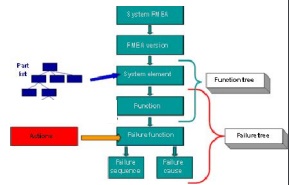Chapter: Mechanical : Maintenance Engineering : Repair Methods For Basic Machine Elements
FMEA - Failure Modes and Effects Analysis
FMEA
- Failure Modes and Effects Analysis
The main goal of the FMEA (Failure Mode and
Effect Analysis) is to prevent failures. Therefor it belongs to the important
tools of the quality planning. It is assumed that the general meaning is known.
iQ-FMEA
has been developed under various aspects:
the system has to meet the practical
requirements according to the VDA series of publications
it has to support
the structured process of FMEA sessions through algorithms, tables and methods
the history of a FMEA is to be shown for every step of improvement
experiences (knowledge base) of
previous FMEAs have to be able to enter in current FMEAs. Therefor certain parts
of a FMEA are emphasized as standard. They are independent of the current
product or process.
employees without a lot of
knowledge about information processing have also be able to use the FMEA

FMEA header, that contains
general information for the most common standard forms FMEA versions; each
version describes a segment of the FMEA-development
system elements as units for
analysis functions of a system element possible malfunctions of a function
integrated knowledge base
extensive provisions for
action management
The structure elements in
detail
FMEA header
FMEA id and short description
FMEA type
method of evaluation material
drawings
initial part/process or
optimization analysis extensive text description
entire status of the FMEA
Version
FMEA can have several
versions.
One version describes the
FMEA progress from the realisation of corrective actions to the recommendation
of further actions. A new version closes the predecessor.
cost input after each
session; time and money investments in persons; direct costs cost cumulation
over all sessions of a version and over the whole period of a FMEA divers
further management data on version level
System elements (SE)
any number of system elements
in a version
assignment of a system
element to a SE class. This makes it possible to define arbitrarily structured
search criteria (knowledge base).
SEs can be ordered
hierarchically in a parts list structure
Function and error tree
SEs within the SE hierarchy
are in following relationship with each other: the function of the inferior SEs
(rubberlip) builds a chain to the superior (sealing ring), the function tree
one FMEA may contain several
function trees
the function tree can be set
up top down or bottom up
errors on a lower level can
automatically be taken as a failure cause on a higher level complete support of
system FMEA (see form)
Failure analysis
failure analysis
can be considered in isolation for each malfunction failure analysis can be
made within the function tree
a failure can cause several consecutive
failures
a failure can result from several reasons
you can assign the RPZ factor meaning to a failure sequence
you can assign the RPZ factor occurrence probability and detectability to a failure cause B, E and A from a catalogue, which can be created by the user (VDA, DGQ etc.)
Adjustment actions
The complete feature set of iQ-Projekte is used differentiation in preventive actions (design engineer) and detecting actions (later quality assurance) information about responsible person, appointments, performance, estimation of planned improvements etc. appointment traceability, follow-up actions in case of missed deadlines etc.
FMEA form
form for complete FMEA
form for certain system elements
Knowledgebase
structure
and identification of FMEAs and SEs, which appear similar in other
constructions or processes (for example bore for fit, rotation and parallel
translation)
search algorithms based on class systems
adoption of already described SEs, depending
on RPZ-experiences
Analysis
history of a FMEA
about the version Pareto-diagram to
a version over RPZ
graphic
comparison of the RPZs over SEs and
functions between two versions standard forms
Related Topics